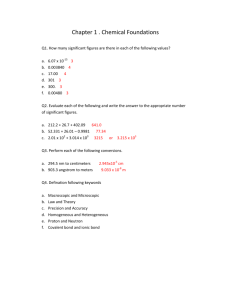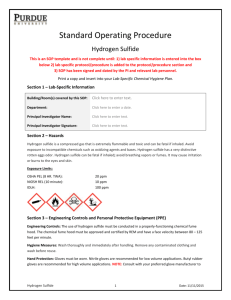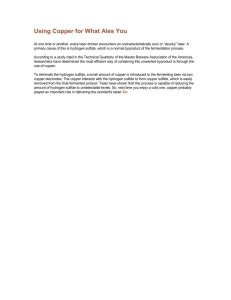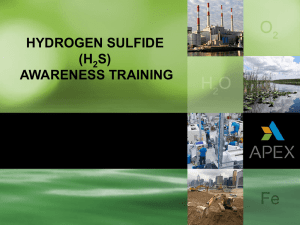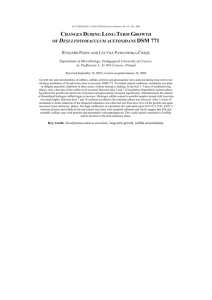Ammonium Sulfide 46-52%
advertisement
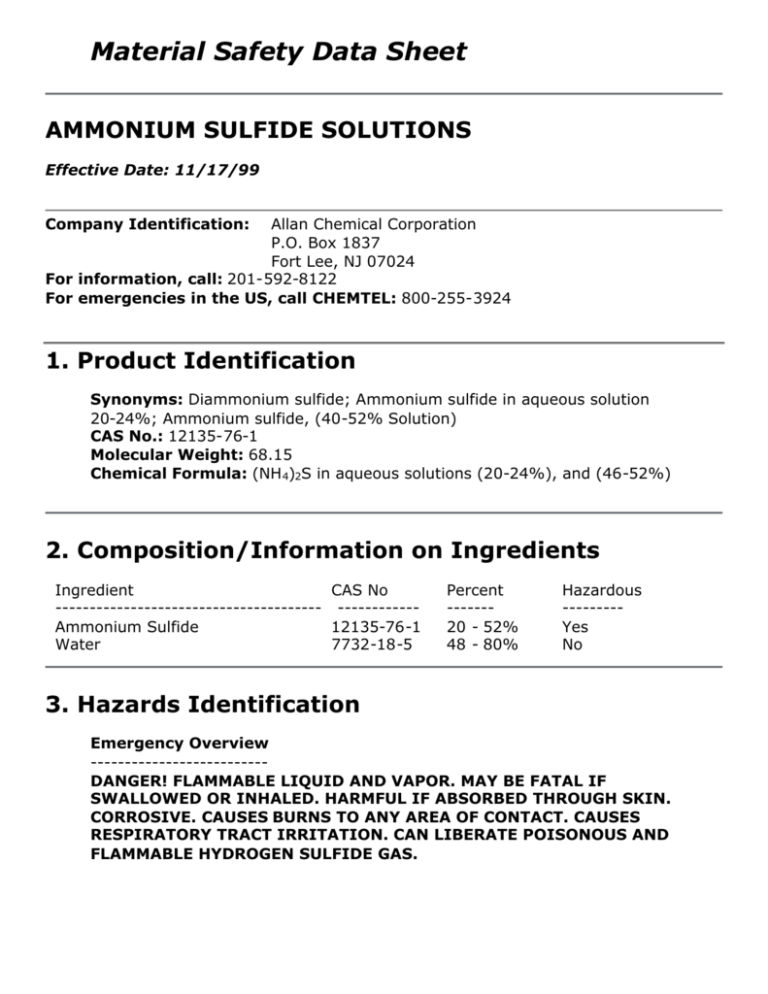
Material Safety Data Sheet AMMONIUM SULFIDE SOLUTIONS Effective Date: 11/17/99 Company Identification: Allan Chemical Corporation P.O. Box 1837 Fort Lee, NJ 07024 For information, call: 201-592-8122 For emergencies in the US, call CHEMTEL: 800-255-3924 1. Product Identification Synonyms: Diammonium sulfide; Ammonium sulfide in aqueous solution 20-24%; Ammonium sulfide, (40-52% Solution) CAS No.: 12135-76-1 Molecular Weight: 68.15 Chemical Formula: (NH 4)2S in aqueous solutions (20-24%), and (46-52%) 2. Composition/Information on Ingredients Ingredient CAS No --------------------------------------- -----------Ammonium Sulfide 12135-76-1 Water 7732-18-5 Percent ------20 - 52% 48 - 80% Hazardous --------Yes No 3. Hazards Identification Emergency Overview -------------------------DANGER! FLAMMABLE LIQUID AND VAPOR. MAY BE FATAL IF SWALLOWED OR INHALED. HARMFUL IF ABSORBED THROUGH SKIN. CORROSIVE. CAUSES BURNS TO ANY AREA OF CONTACT. CAUSES RESPIRATORY TRACT IRRITATION. CAN LIBERATE POISONOUS AND FLAMMABLE HYDROGEN SULFIDE GAS. Potential Health Effects ---------------------------------Inhalation: Inhalation of vapors causes irritation to the respiratory tract; symptoms may include coughing and shortness of breath. Concentrations of hydrogen sulfide above 50 ppm may cause headache, insomnia, nausea, sore throat, dizziness, drowsiness, and pulmonary edema. Above 600 ppm for 30 minutes can cause death. Ingestion: May be corrosive to the gastrointestinal tract through liberation of hydrogen sulfide. Can cause nausea, vomiting, headache, cyanosis, respiratory depression, blood pressure fall, unconsciousness, tremors, convulsions, and death. Skin Contact: Causes irritation, redness, and pain. May be absorbed through skin and cause hydrogen sulfide poisoning. Eye Contact: Splashes can cause burns to the eyes. Vapors can cause irritation with redness and pain. Chronic Exposure: Chronic exposure may cause damage to exposed tissues. Aggravation of Pre-existing Conditions: Persons with pre-existing pulmonary diseases may be more susceptible to the effects of this substance. 4. First Aid Measures Inhalation: Remove to fresh air. If not breathing, give artificial respiration. If breathing is difficult, give oxygen. Get medical attention immediately. Ingestion: If swallowed, DO NOT INDUCE VOMITING. Give large quantities of water. Never give anything by mouth to an unconscious person. Get medical attention immediately. Skin Contact: Immediately flush skin with plenty of water for at least 15 minutes while removing contaminated clothing and shoes. Get medical attention immediately. Wash clothing before reuse. Thoroughly clean shoes before reuse. Eye Contact: Immediately flush eyes with plenty of water for at least 15 minutes, lifting lower and upper eyelids occasionally. Get medical attention immediately. 5. Fire Fighting Measures Fire: Flash point: 22C (72F) CC Flammable limits in air % by volume: lel: 4; uel: 46 Flammable liquid and vapor! Listed fire data is for Pure Ammonium Sulfide. The flashpoint of a 20-24% solution of ammonium sulfide is 60C (140F) (closed cup). Toxic hydrogen sulfide gas is released when heated. If ignited, irritating sulfur dioxide gas will form. Explosion: Not considered an explosion hazard, but contact with powerful oxidizers may cause an explosion. Sealed containers may rupture when heated. Contact with strong oxidizers may cause fire. Sensitive to static discharge. Fire Extinguishing Media: Use water in flooding quantities as fog; solid streams of water may be ineffective to knock down vapors. DO NOT USE CARBON DIOXIDE AS FLAMMABLE, TOXIC HYDROGEN SULFIDE GAS CAN BE GENERATED. Apply water from as far a distance as possible. Alcohol foam or dry chemical may be used. Special Information: In the event of a fire, wear full protective clothing and NIOSH-approved self-contained breathing apparatus with full facepiece operated in the pressure demand or other positive pressure mode. 6. Accidental Release Measures Ventilate area of leak or spill. Remove all sources of ignition. Wear appropriate personal protective equipment as specified in Section 8. Isolate hazard area. Keep unnecessary and unprotected personnel from entering. Contain and recover liquid when possible. Use non-sparking tools and equipment. Collect liquid in an appropriate container or absorb with an inert material (e. g., vermiculite, dry sand, earth), and place in a chemical waste container. Do not use combustible materials, such as saw dust. Do not flush to sewer! US Regulations (CERCLA) require reporting spills and releases to soil, water and air in excess of reportable quantities. The toll free number for the US Coast Guard National Response Center is (800) 424-8802. If a leak or spill has not ignited, use water spray to disperse the vapors, to protect personnel attempting to stop leak, and to flush spills away from exposures. 7. Handling and Storage Protect against physical damage. Outside or detached storage is preferred. Inside storage should be a standard flammable liquids storage room or cabinet. Separate from acids and oxidizing materials. Storage and use areas should be no smoking areas. Isolate from incompatible substances. Toxic hydrogen sulfide and ammonia gases may collect in enclosed spaces. Containers of this material may be hazardous when empty since they retain product residues (vapors, liquid); observe all warnings and precautions listed for the product. 8. Exposure Controls/Personal Protection Airborne Exposure Limits: -OSHA Permissible Exposure Limit (PEL): Hydrogen sulfide: 10 ppm (TWA), 15 ppm (STEL) Ammonia: 50 ppm (TWA) -ACGIH Threshold Limit Value (TLV): Hydrogen sulfide gas: 10 ppm (TWA) 15 ppm (STEL) Ammonia: 25 ppm (TWA), 35 ppm (STEL) Ventilation System: A system of local and/or general exhaust is recommended to keep employee exposures below the Airborne Exposure Limits. Local exhaust ventilation is generally preferred because it can control the emissions of the contaminant at its source, preventing dispersion of it into the general work area. Please refer to the ACGIH document, Industrial Ventilation, A Manual of Recommended Practices, most recent edition, for details. Personal Respirators (NIOSH Approved): If the exposure limit is exceeded, wear a supplied air, full-facepiece respirator, air-lined hood, or full-facepiece self-contained breathing apparatus. This substance has poor warning properties. Skin Protection: To prevent skin contact, wear impervious protective clothing, including boots, gloves, lab coat, apron or coveralls, as appropriate. Eye Protection: Use chemical safety goggles and/or a full face shield where splashing is possible. Maintain eye wash fountain and quick-drench facilities in work area. 9. Physical and Chemical Properties Appearance: Clear, yellow liquid. Odor: Strong odor of sulfide and ammonia. Solubility: Infinitely soluble. Density: ca. 1.0 @ 20C (68F) pH: 9.5 ( 45% aqueous solution) % Volatiles by volume @ 21C (70F): 100 Boiling Point: Decomposes. Melting Point: No information found. Vapor Density (Air=1): No information found. Vapor Pressure (mm Hg): No information found. Evaporation Rate (BuAc=1): No information found. 10. Stability and Reactivity Stability: Stable under ordinary conditions of use and storage. May lose integrity with age; ammonium sulfide slowly produces hydrogen sulfide and ammonia in the presence of moisture. Hazardous Decomposition Products: Emits toxic fumes of sulfur oxides, nitrogen oxides, hydrogen sulfide, ammonium bisulfite, and ammonia when heated to decomposition. Hazardous Polymerization: Will not occur. Incompatibilities: Contact with acids may evolve hydrogen sulfide. Oxidizers, zinc. Severely corrodes copper, zinc and their alloys. Conditions to Avoid: Heat, flames, ignition sources and incompatibles. 11. Toxicological Information No LD50/LC 50 information found relating to normal routes of occupational exposure. --------\Cancer Lists\--------------------------------------------------------NTP Carcinogen--Ingredient Known Anticipated IARC Category -------------------------------------------------------------Ammonium Sulfide (12135-76-1) No No None Water (7732-18-5) No No None 12. Ecological Information Environmental Fate: No information found. Environmental Toxicity: No information found. 13. Disposal Considerations Whatever cannot be saved for recovery or recycling should be handled as hazardous waste and sent to a RCRA approved waste facility. Processing, use or contamination of this product may change the waste management options. State and local disposal regulations may differ from federal disposal regulations. Dispose of container and unused contents in accordance with federal, state and local requirements. 14. Transport Information Domestic (Land, D.O.T.) ----------------------Proper Shipping Name: AMMONIUM SULFIDE SOLUTION Hazard Class: 8, 6.1, 3 UN/NA: UN2683 Packing Group: II International (Water, I.M.O.) ----------------------------Proper Shipping Name: AMMONIUM SULPHIDE, SOLUTION Hazard Class: 8, 6.1, 3.3 UN/NA: UN2683 Packing Group: II 15. Regulatory Information --------\Chemical Inventory Status - Part 1\--------------------------------Ingredient TSCA EC Japan Australia ----------------------------------------------- -----------------Ammonium Sulfide (12135-76-1) Yes Yes Yes Yes Water (7732-18-5) Yes Yes Yes Yes --------\Chemical Inventory Status - Part 2\----------------------------------Canada-Ingredient Korea DSL NDSL Phil. ----------------------------------------------- -------------Ammonium Sulfide (12135-76-1) Yes Yes No No Water (7732-18-5) Yes Yes No Yes --------\Federal, State & International Regulations - Part 1\----------------SARA 302- ------SARA 313-----Ingredient RQ TPQ List Chemical Catg. --------------------------------------------------------------Ammonium Sulfide (12135-76-1) No No No No Water (7732-18-5) No No No No --------\Federal, State & International Regulations - Part 2\----------------RCRA-TSCAIngredient CERCLA 261.33 8(d) -------------------------------------------------------Ammonium Sulfide (12135-76-1) 100 No No Water (7732-18-5) No No No Chemical Weapons Convention: No TSCA 12(b): No CDTA: No SARA 311/312: Acute: Yes Chronic: Yes Fire: Yes Pressure: No Reactivity: Yes (Mixture / Liquid) Australian Hazchem Code: 2X Poison Schedule: No information found. WHMIS: This MSDS has been prepared according to the hazard criteria of the Controlled Products Regulations (CPR) and the MSDS contains all of the information required by the CPR. 16. Other Information NFPA Ratings: Health: 3 Flammability: 3 Reactivity: 0 Disclaimer: ************************************************************* Allan Chemical Corp. provides the information contained herein in good faith but makes no representation as to its comprehensiveness or accuracy. This document is intended only as a guide to the appropriate precautionary handling of the material by a properly trained person using this product. Individuals receiving the information must exercise their independent judgment in determining its appropriateness for a particular purpose. ALLAN CHEMICAL CORP. MAKES NO REPRESENTATIONS OR WARRANTIES, EITHER EXPRESS OR IMPLIED, INCLUDING WITHOUT LIMITATION ANY WARRANTIES OF MERCHANTABILITY, FITNESS FOR A PARTICULAR PURPOSE WITH RESPECT TO THE INFORMATION SET FORTH HEREIN OR THE PRODUCT TO WHICH THE INFORMATION REFERS. ACCORDINGLY, ALLAN CHEMICAL CORP. WILL NOT BE RESPONSIBLE FOR DAMAGES RESULTING FROM USE OF OR RELIANCE UPON THIS INFORMATION. *************************************************************

